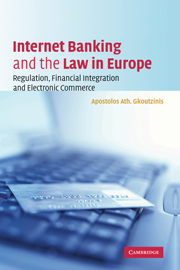Book contents
- Frontmatter
- Contents
- Tables
- Preface
- Tables of legislation
- Table of EU legislation
- Table of international conventions
- Table of cases
- Abbreviations
- Introduction
- PART I Introduction to electronic finance and Internet banking
- 1 Internet banking in Europe: basic concepts and recent trends
- 2 The legal foundations of electronic banking activities
- PART II Online banking and international market access: The causes of incomplete financial integration and what to do about them
- PART III EU harmonization and convergence of national laws relating to electronic banking activities
- PART IV Applicable law and allocation of regulatory responsibility in cross-border electronic banking activities
- Conclusions
- Select bibliography
- Index
1 - Internet banking in Europe: basic concepts and recent trends
Published online by Cambridge University Press: 11 August 2009
- Frontmatter
- Contents
- Tables
- Preface
- Tables of legislation
- Table of EU legislation
- Table of international conventions
- Table of cases
- Abbreviations
- Introduction
- PART I Introduction to electronic finance and Internet banking
- 1 Internet banking in Europe: basic concepts and recent trends
- 2 The legal foundations of electronic banking activities
- PART II Online banking and international market access: The causes of incomplete financial integration and what to do about them
- PART III EU harmonization and convergence of national laws relating to electronic banking activities
- PART IV Applicable law and allocation of regulatory responsibility in cross-border electronic banking activities
- Conclusions
- Select bibliography
- Index
Summary
Since the late 1990s the Internet and other technological advances in telecommunications, information technology and computer software and hardware have transformed the provision of financial services and the structure of financial markets. By the end of the 1990s, electronic finance applications had influenced most aspects of the business of banking, with the exception perhaps of large-value corporate lending. Similarly in the field of capital markets, the Internet has transformed the financial landscape by enabling the seamless interaction among issuers, investors and securities firms.
The Internet as catalyst of international financial integration
The concept of electronic finance may broadly be defined as the provision of financial services and the creation of financial markets using information technology, telecommunications and computer networks. Although the advent of electronic finance has rightly been associated with the most recent application of advanced technologies in the financial services industry, in strictly technical terms e-finance predates the era of the Internet by several decades: the first era of electronic banking in the form of telegraphic fund transfers in the late 19th century gave rise to legal problems that would appear familiar to electronic banking lawyers today.
The Internet and the banker–customer relationship
Electronic banking can be defined as the provision of banking services and the initiation and performance of payments through the banking system by electronic means and other advanced technologies. Electronic banking is a conceptually generic term, which denotes banking services provided through a variety of access devices and links of communication (see figure 1.1).
- Type
- Chapter
- Information
- Internet Banking and the Law in EuropeRegulation, Financial Integration and Electronic Commerce, pp. 7 - 28Publisher: Cambridge University PressPrint publication year: 2006



